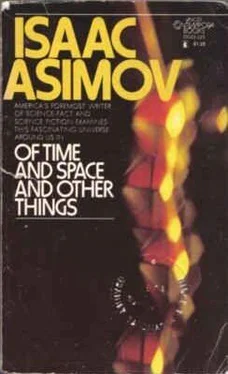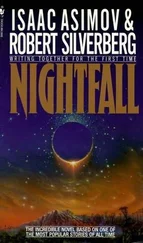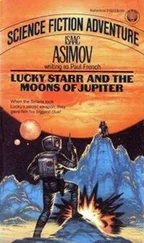Isaac Asimov - Of Time and Space and Other Things
Здесь есть возможность читать онлайн «Isaac Asimov - Of Time and Space and Other Things» весь текст электронной книги совершенно бесплатно (целиком полную версию без сокращений). В некоторых случаях можно слушать аудио, скачать через торрент в формате fb2 и присутствует краткое содержание. Год выпуска: 1972, ISBN: 1972, Издательство: Lancer Books, Жанр: Прочая научная литература, на английском языке. Описание произведения, (предисловие) а так же отзывы посетителей доступны на портале библиотеки ЛибКат.
- Название:Of Time and Space and Other Things
- Автор:
- Издательство:Lancer Books
- Жанр:
- Год:1972
- ISBN:ISBN: 0-447-33023-3
- Рейтинг книги:4 / 5. Голосов: 1
-
Избранное:Добавить в избранное
- Отзывы:
-
Ваша оценка:
- 80
- 1
- 2
- 3
- 4
- 5
Of Time and Space and Other Things: краткое содержание, описание и аннотация
Предлагаем к чтению аннотацию, описание, краткое содержание или предисловие (зависит от того, что написал сам автор книги «Of Time and Space and Other Things»). Если вы не нашли необходимую информацию о книге — напишите в комментариях, мы постараемся отыскать её.
Of Time and Space and Other Things — читать онлайн бесплатно полную книгу (весь текст) целиком
Ниже представлен текст книги, разбитый по страницам. Система сохранения места последней прочитанной страницы, позволяет с удобством читать онлайн бесплатно книгу «Of Time and Space and Other Things», без необходимости каждый раз заново искать на чём Вы остановились. Поставьте закладку, и сможете в любой момент перейти на страницу, на которой закончили чтение.
Интервал:
Закладка:
9. The Black Of Night
I suppose many of you are familiar with the comic strip "Peanuts." My daughter Robyn (now in the fourth grade) is very fond of it, as I am myself.
She came to me one day, delighted with a particular sequence in which one of the little characters in "Peanuts" asks his bad-tempered older sister, "Why is the sky blue,?" and she snaps back, "Because it isn't green!"
When Robyn was all through laughing, I thought I would seize the occasion to maneuver the conversation in the direction of a deep and subtle scientific discussion (entirely for Robyn's own good, you understand). So I said, "Wen, tell me, Robyn, why is the night sky black?"
And she answered at once (I suppose I ought to have foreseen it), "Because it isn't purple!"
Fortunately, nothing like this can ever seriously frustrate me. If Robyn won't cooperate, I can always turn, with a snarl, on the Helpless Reader. I will discuss the blackness of the night sky with youl
Ile story of the black of night begins with a German physician and astronomer, Heinrich Wilhelm Matthias Olbers, bom in 1758. He practiced astronomy as a hobby, and in midlife suffered a peculiar disappointment. It came about in this fashion…
Toward the end of the eighteenth century, astronomers began to suspect, quite strongly, that some sort of planet must exist between the orbits of Mars and Jupiter. A team of German astronomers, of whom Olbers was one of the most important, set themselves up with the intention of dividing the ecliptic among themselves and each searching his own portion, meticulously, for the planet.
Olbers and his friends were so systematic and thorough that by rights they should have discovered the planet and received the credit of it. But life is funny (to coin a phrase).
While they were still arranging the details, Giuseppe Piazzi, an Italian astronomer who wasn't looking for planets at all, discovered, on the night of January 1, 1801, a point of light which had shifted its position against the background of stars. He followed it for a period of time and found it was continuing to move steadily. It moved less rapidly than
Mars and more rapidly than Jupiter, so it was very likely a planet in an intermediate orbit. He reported it as such so :hat it was the casual Piazzi and not the thorough Olbers who got the nod in the history books.
Olbers didn't lose out altogether, however. It seems that after a period of time, Piazzi fell sick and was unable to continue his observations. By the time he got back to the telescope the planet was too close to the Sun to be observ able.
Piazzi didn't have enough observations to calculate an orbit and this was bad. It would take months for the slow-moving planet to get to the other side of the Sun and into observable position, and without a calculated orbit it might easily take years to rediscover it.
Fortunately, a young German mathematician, Karl Friedrich Gauss, was just blazing his way upward into the mathematical firmament. He had worked out something called the "method of least squares," which made it possible to calculate a reasonably good orbit from no more than three good observations of a planetary position.
Gauss calculated the orbit of Piazzi's new planet, and when it was in observable range once more there was Olbers and his telescope watching the place where Gauss's calcula tions said it would be. Gauss was right and, on January 1, 1802, Olbers found it.
To be sure, the new planet (named "Ceres") was a peculiar one, for it turned out to be less than 500 miles in diameter. It was far smaller than any other known planet and smaller than at least six of the satellites known at that time.
Could Ceres be all that existed between Mars and Jupiter? The German astronomers continued looking (it would be a shame to waste all that preparation) and sure enough, three more planets between Mars and Jupiter were soon discovered. Two of them, Pallas and Vesta, were dis covered by Olbers. (In later years many more were discovered.)
But, of course, the big payoff isn't for second place. All Olbers got out of it was the name of a planetoid. The thou sandth planetoid between Mars and Jupiter was named "Piazzia," the thousand and first "Gaussia," and the thou sand and second (hold your breath, now) "Olberia."
Nor was Olbers much luckier in his other observations.
He specialized in comets and discovered five of them, but practically anyone can do that. There is a comet called "Olbers' Comet" in consequence, but that is a minor dis tinction.
Shall we now dismiss Olbers? By no means.
It is hard to tell just what will win you a place in the annals of science. Sometimes it is a piece of interesting reverie that does it. In 1826 Olbers indulged himself in an idle speculation concerning the black of night and dredged out of it an'apparently ridiculous conclusion.
Yet that speculation became "Olbers' paradox," which has come to have profound significance a century after ward. In fact, we can begin with Olbers' paradox and end with the conclusion that the only reason life exists any where in the universe is that the distant galaxies are reced ing from us.
What possible effect can the distant galaxies have on us?
Be patient now and we'll work it out.
In ancient times, if any astronomer had been asked why the night sky was black, he would have answered-quite reasonably-that it was because the light of the Sun was absent. If one had then gone on to question him why the stars did not take the place of the Sun, he would have answered-again reasonably-that the stars were limited in number and individually dim. In fact, all the stars we can see would, if lumped together, be only a half-birionth as bright as the Sun. Their influence on the blackness of the night sky is therefore insignificant.
By the nineteenth century, however, this last argument had lost its force. The number of stars was tremendous.
Large telescopes revealed them by the countless millions.
Of course, one might argue that those countless millions of stars were of no importance for they were not visible to the naked eye and therefore did not contribute to the light in the night sky. This, too, is a useless argument. The stars of the Milky Way are, individually, too faint to be made out, but en masse they make a dimly luminous belt about the sky. The Andromeda galaxy is much farther away than the stars of the Milky Way and the individual stars that make it up are not individually visible except (just barely) in a very large telescope. Yet, en masse, the Andromeda galaxy is faintly visible to the naked eye. (It'is, in fact, the farthest object visible to the unaided eye; so if anyone ever asks you how far you can see; tell him 2,000,000 light years.)
In short distant stars-no matter how distant and no matter how dim, individually-must contribute to the light of the night sky, and this contribution can even become detectable without the aid of instruments if these dim distant stars exist in sufficient density.
Olbers, who didn't know about the Andromeda galaxy, but did know about the Milky Way, therefore set about asking himself how much light ought to be expected from the distant stars altogether. He began by making several assumptions:
1. That the universe is infinite in extent.
2. That the stars are infinite in number and evenly spread throughout the universe.
3. That the stars are of uniform average brightness through all of space.
Now let's imagine space divided up into shells (like those of an onion) centering about us, comparatively thin. shells compared with the vastness of space, but large enough to contain stars within them.
Remember that the amount of light that reaches us from individual stars of equal luminosity varies inversely as the square of the distance from us. In other words, if Star A and Star B are equally bright but Star A is three times as far as Star B, Star A delivers only % the light. If Star A were five times as far as Star B, Star A would deliver 1/2r, the light, and so on.
Читать дальшеИнтервал:
Закладка:
Похожие книги на «Of Time and Space and Other Things»
Представляем Вашему вниманию похожие книги на «Of Time and Space and Other Things» списком для выбора. Мы отобрали схожую по названию и смыслу литературу в надежде предоставить читателям больше вариантов отыскать новые, интересные, ещё непрочитанные произведения.
Обсуждение, отзывы о книге «Of Time and Space and Other Things» и просто собственные мнения читателей. Оставьте ваши комментарии, напишите, что Вы думаете о произведении, его смысле или главных героях. Укажите что конкретно понравилось, а что нет, и почему Вы так считаете.












